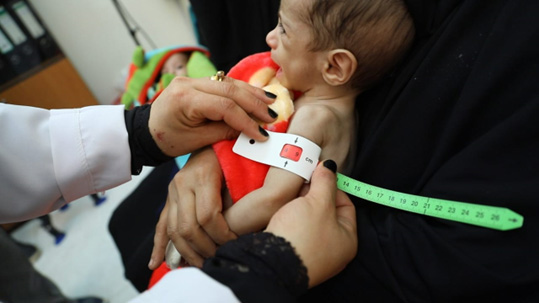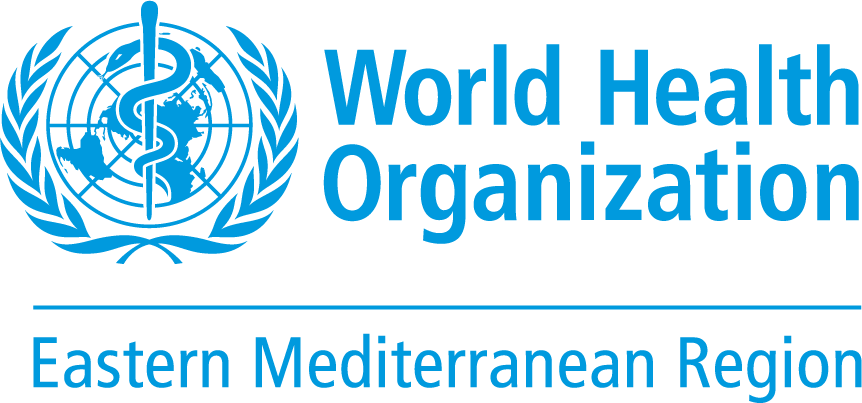 A young child is screened for malnutrition at one of the TFCs supported by EHCP. Photo credit: WHO/WHO Yemen15 July 2024, Aden and Sana’a, Yemen – Throughout the decade-long conflict in Yemen, malnutrition has been a devastating mainstay among children aged under 5 years.
A young child is screened for malnutrition at one of the TFCs supported by EHCP. Photo credit: WHO/WHO Yemen15 July 2024, Aden and Sana’a, Yemen – Throughout the decade-long conflict in Yemen, malnutrition has been a devastating mainstay among children aged under 5 years.
WHO Representative to Yemen Dr Arturo Pesigan described the current situation: “With increases in the incidence of measles and cholera in 2023, undernutrition has increased as a secondary impact.”
At WHO therapeutic feeding centres (TFCs), admissions for severe acute malnutrition with medical complications have almost doubled in recent years, from 32 000 in 2020 to 62 000 in 2023. This increase also reflects the increased accessibility of services by communities, owing to WHO’s awareness, advocacy and supportive supervision to improve quality of care for communities.
Since 2017, WHO and the World Bank have worked together to sustain and expand access for affected communities to nutrition surveillance and therapeutic feeding services. This has been done through the Emergency Health and Nutrition Project (EHNP), active until 2022, and the Emergency Human Capital Project (EHCP), ongoing since 2021.
In 2024, WHO continues to provide full operational support to 62 TFCs via EHCP. These TFCs manage over 75% of all cases received by WHO-supported TFCs (which account for 68% of all TFCs in Yemen). The treatment success rate at these 62 TFCs exceeds 95% and all performance indicators meet the Sphere Minimum Standards in food security and nutrition, including a death rate of 1% and default rate of 2%. WHO’s support to TFCs includes distribution of medical supplies, transport and meal allowances for caregivers, and other operational support to ensure the effective delivery of TFC services.
Through EHCP, WHO also provides support to 340 surveillance sites across Yemen that measure children for undernutrition. In 2023, more than 1 million children were screened at these sites. Among them, 25% were identified as undernourished and referred for life-saving treatment. Stunting was detected among 44% of all children screened – almost the same proportion as found by Yemen’s most recent Standardized Monitoring and Assessment of Relief and Transition (SMART) survey. Stunting remains an issue of high concern and high prevalence in more than 175 of Yemen’s 333 districts, according to analysis of nutrition surveillance data.
 A midwife and nurse attend the data reporting and quality assurance training supported by the World Bank in collaboration with the health authorities. Photo credit: WHO/WHO YemenOf the children screened for undernutrition in 2023, 21% were aged under 6 months – of whom only 14% were exclusively breastfed. This lags significantly behind the WHO global target for countries to reach an exclusive breastfeeding rate of 50% by 2025. The consistently low rates of exclusive breastfeeding in Yemen likely contribute to the high levels of undernutrition that persist.
A midwife and nurse attend the data reporting and quality assurance training supported by the World Bank in collaboration with the health authorities. Photo credit: WHO/WHO YemenOf the children screened for undernutrition in 2023, 21% were aged under 6 months – of whom only 14% were exclusively breastfed. This lags significantly behind the WHO global target for countries to reach an exclusive breastfeeding rate of 50% by 2025. The consistently low rates of exclusive breastfeeding in Yemen likely contribute to the high levels of undernutrition that persist.
WHO, in partnership with the health authorities, is advocating for and supporting the integration of nutrition surveillance activities into routine maternal, new born and child health service delivery platforms. This is in line with the paradigm shift from humanitarian support to more development-oriented action that can provide durable and sustainable solutions. Currently, this surveillance approach is being piloted in 75 targeted health facilities in 10 governorates. The next step is to integrate nutrition assessment into all child health service delivery platforms, starting with Essential Programme on Immunization (EPI) services in the Expanded Programme on Immunization.
This integrated approach has been initiated with 579 health workers (mainly midwives and nurses; 85% female). These health workers have been trained on a comprehensive package of nutrition assessment methods, enabling them to screen mothers and newborns at the targeted health facilities during the pilot. They also received training on data reporting, analysis and use at the different levels of the health system.
Nutrition assessment for women and newborns in targeted facilities and data quality assurance and analysis are ongoing. Data quality assurance involves several steps of validation and monitoring, starting with assuring the accuracy of nutrition assessment at health facility level via supportive supervision visits by trained focal points in the districts/governorates. It also requires continuous mentoring for data managers on data reporting, through regular data chain quality assurance for each reported indicator. Going forward, WHO will continue to rollout and expand the integrated approach, focusing on data quality assurance, supportive supervision and mentoring, towards saving lives and enhancing the delivery of quality care for undernourished children in Yemen.
Related links
Fighting to survive: saving the lives of Yemeni malnourished children




